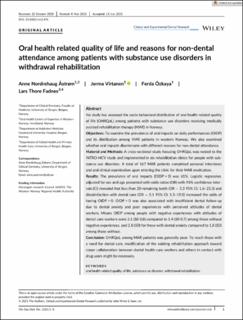| dc.contributor.author | Åstrøm, Anne Nordrehaug | |
| dc.contributor.author | Virtanen, Jorma | |
| dc.contributor.author | Özkaya, Ferda | |
| dc.contributor.author | Fadnes, Lars Thore | |
| dc.date.accessioned | 2022-01-24T13:35:20Z | |
| dc.date.available | 2022-01-24T13:35:20Z | |
| dc.date.created | 2021-08-11T14:33:49Z | |
| dc.date.issued | 2021 | |
| dc.identifier.issn | 2057-4347 | |
| dc.identifier.uri | https://hdl.handle.net/11250/2838987 | |
| dc.description.abstract | No study has assessed the socio-behavioral distribution of oral health related quality of life (OHRQoL) among patients with substance use disorders receiving medically assisted rehabilitation therapy (MAR) in Norway.
Objectives
To examine the prevalence of oral impacts on daily performances (OIDP) and its distribution among MAR patients in western Norway. We also examined whether oral impacts discriminate with different reasons for non-dental attendance.
Material and Methods
A cross-sectional study focusing OHRQoL was nested to the INTRO-HCV study and implemented in six rehabilitation clinics for people with substance use disorders. A total of 167 MAR patients completed personal interviews and oral clinical examination upon entering the clinic for their MAR medication.
Results
The prevalence of oral impacts (OIDP > 0) was 61%. Logistic regression, adjusted for sex and age presented with odds ratios (OR) with 95% confidence intervals (CI) revealed that less than 20 remaining teeth (OR = 5.3 95% CI: 1.6–23.3) and dissatisfaction with dental care (OR = 5.1 95% CI: 1.3–19.0) increased the odds of having OIDP > 0. OIDP > 0 was also associated with insufficient dental follow-up due to dental anxiety and poor experiences with perceived attitudes of dental workers. Means OIDP among people with negative experiences with attitudes of dental care workers were 3.1 (SD 0.8) compared to 1.4 (SD 0.7) among those without negative experiences, and 2.8 (SD) for those with dental anxiety compared to 1.8 (SD) among those without.
Conclusion
OHRQoL among MAR patients was generally poor. To reach those with a need for dental care, modification of the existing rehabilitation approach toward closer collaboration between dental health care workers and others in contact with drug users might be necessary. | en_US |
| dc.language.iso | eng | en_US |
| dc.publisher | Wiley | en_US |
| dc.rights | Navngivelse 4.0 Internasjonal | * |
| dc.rights.uri | http://creativecommons.org/licenses/by/4.0/deed.no | * |
| dc.title | Oral health related quality of life and reasons for non-dental attendance among patients with substance use disorders in withdrawal rehabilitation | en_US |
| dc.type | Journal article | en_US |
| dc.type | Peer reviewed | en_US |
| dc.description.version | publishedVersion | en_US |
| dc.rights.holder | Copyright 2021 The Author(s) | en_US |
| cristin.ispublished | true | |
| cristin.fulltext | original | |
| cristin.fulltext | original | |
| cristin.qualitycode | 1 | |
| dc.identifier.doi | 10.1002/cre2.476 | |
| dc.identifier.cristin | 1925356 | |
| dc.source.journal | Clinical and Experimental Dental Research | en_US |
| dc.identifier.citation | Clinical and Experimental Dental Research. 2021 | en_US |

